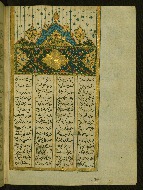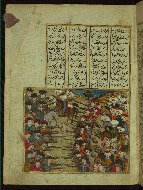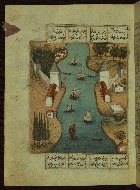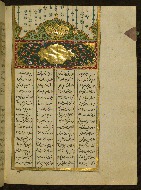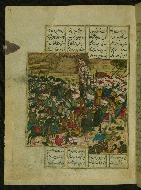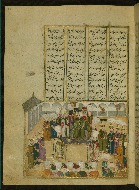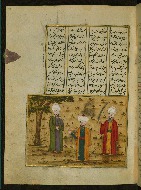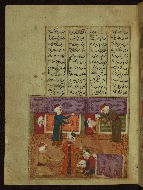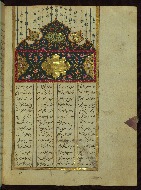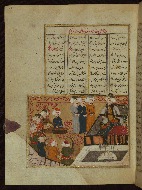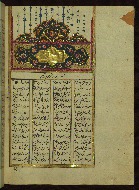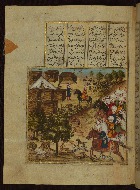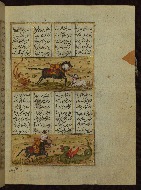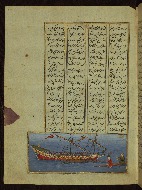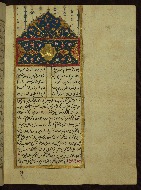Home > Digitized Walters Manuscripts
This document is a tranformation of a TEI P5 XML manuscript description incorporating images. If you have trouble reading special or non-Latin characters on this page, please make sure you have appropriate Unicode fonts installed and an up-to-date web browser.
Walters Ms. W.666, Five poems (quintet)
Browse images (Browse images in a new window) | TEI in XML format
W.666
Five poems (quintet)
Vernacular: خمسۂ عطاۓ
Authority name: Atai, 15th cent.
As-written name: ʿAṭāʾullāh bin Yaḥyá ʿAṭāʾī
Name, in vernacular: عطاء الله بن يحيى عطاۓ
Known as: Nev`izade
Note: Author dates preferred by cataloger: d. 1044 AH / 1634 CE
This is an illuminated and illustrated copy of the Ḫamse (quintet) of the Ottoman Turkish poet and scholar ʿAṭāʾullāh bin Yaḥyá ʿAṭāʾī (d. 1044 AH / 1634 CE). Although different in content, this work takes its inspiration from the famous Persian Khamsah of Niẓāmī Ganjavī (d. 605 AH / 1209 CE) and the Khamsah of Amīr Khusraw Dihlavī (d. 725 AH / 1325 CE). This Ottoman copy of ʿAṭāʾī's work ends with a portion of his Dīvān (fols. 142b-151b) instead of the fifth poem (mesnevi), Ḥilyet ül-efkār. The text, written in nastaʿlīq script, was copied by Ḫeyrullah Ḫeyrī Çāvuşzade in 1133 AH / 1721 CE. There are thirty-eight illustrations, and illuminated incipits introduce the different poems (fols. 1b, 22b, 63b, 107b, and 142b). The brown leather binding is original to the manuscript.
9 Jumādá II -- Rajab 1133 AH / 1721 CE (fols. 20b, 62b)
Turkey
As-written name: Khayr Allāh Khayrī Jāwush Zādah
Name, in vernacular: خير الله خيري جاوش زاده
Note: Scribe name in Turkish transliteration: Ḫeyrullah Ḫeyrī Çāvuşzade
Book
Literary -- Poetry
The primary language in this manuscript is Turkish, Ottoman (1500-1928).
- Transliteration: Fol. 62b: al-ḥamd li-Llāh ʿalá al-tamām wa-ʿlá rasūlih wa-<ā>lih afḍal al-ṣalāh wa-al-salām /1/ ʿalá yad afqar al-wará Khayr Allāh Jāwush zādah mattaʿanā Allāh /2/ bi-al-ḥusná wa-ziyādah [sic] qad waqaʿa al-farāgh min taḥrīr hadhihi /3/ al-nuskhah al-sharīfah fī waqt al-ḍuḥá yawm al-jumʿah /4/ min awāsiṭ Rajab al-murajjab li-sanat thal<ā>th /5/ wa-thalathīn wa-mi<ʾ>ah wa-alf min /6/ hijrah [sic] al-nabawīyah /7/ m (= tamma) /8/
- Comment: Two colophons (fols. 21a and 62b): the first (in Turkish) giving a fuller name of the scribe; the second (in Arabic) giving the name of the scribe as Khayr Allāh Jāwush Zādah and the date of copying as Friday, mid Rajab 1133 AH / 1721 CE
Paper
Laid paper
Foliation: ii+152+ii
One or more folios missing after fol. 143
Catchwords: Written obliquely on versos
15.5 cm wide by 21.0 cm high
9.5 cm wide by 16.0 cm high
- Columns: 4
- Ruled lines: 21
- Framing lines in black and gold
- Title: Ḫamse-yi ʿAṭāʾī
- Author: Atai, 15th cent.
- Scribe: Khayr Allāh Khayrī Jāwush Zādah
- Incipit: بنام خداوند افلاك وخاك ...
- Text note: Contains: Sāḳīnāme, also known as ʿĀlemnumā (fols. 1b-21b), Nefḥat ül-ezhār (fols. 22b-62b), Sobḥet ül-ebkār (fols. 63b-106b), Heft-ḫvān (fols. 107b-141a), and a portion of Dīvān (fols. 142b-151b, incomplete at end); Sāḳīnāme composed in 1024 AH / 1615 CE (see chronosticon on fol. 20b, col. 2, line 11); Nefḥat ül-ezhār composed in 1034 AH / 1624-5 CE (see date given in abjad: dāl lām ghayn, fol. 61b, col. 1, line 16); Sobḥet ül-ebkār composed in 1033 AH / 1623-4 CE (see chronosticon on fol. 106a); Heft-ḫvān composed in 1036 AH / 1626-7 CE (see fol. 141a, col. 2, line 5)
- Hand note: Written in nastaʿlīq script in black ink with chapter headings in red
- Decoration note: Thirty-eight illustrations; five incipits with illuminated headpieces (fols. 1b, 22b, 63b, 107b, and 142b)
fol. 1b:
fol. 5a:
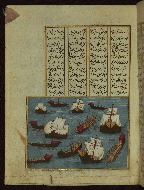
- Title: Ottoman fleet
- Form: Illustration
- Text: Sāḳīnāme
- Label: This illustration depicts the Ottoman fleet, led by Hüseyn Paşa, setting out from the Black Sea against the Polish army.
fol. 6a:
fol. 10a:
fol. 22b:
fol. 27a:
fol. 28a:
fol. 33a:
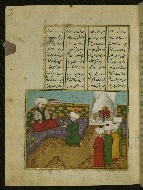
- Title: The poet ʿAṭāʾī reading from his book (Ḫamse) to his master
- Form: Illustration
- Text: Nefḥat ül-ezhār
fol. 35b:
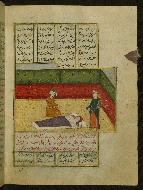
- Title: A Christian girl on her deathbed after converting to Islam
- Form: Illustration
- Text: Nefḥat ül-ezhār
- Label: This illustration depicts the story of a Muslim boy who fell in love with a Christian girl. Unable to unite with her, he dies of grief. His friend delivers the bad news to her, and she converts to Islam in the hopes of being united with her Muslim lover in heaven.
fol. 37a:
fol. 41a:
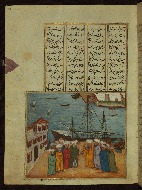
- Title: Şeyh Gülşeni setting out with his disciples on a voyage
- Form: Illustration
- Text: Nefḥat ül-ezhār
fol. 42b:
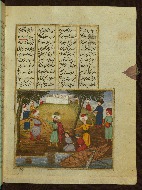
- Title: Şeyh Baba and his men
- Form: Illustration
- Text: Nefḥat ül-ezhār
- Label: This illustration depicts Şeyh Baba and his men capturing a group of brigands who robbed their tekke (dervish lodge).
fol. 44a:
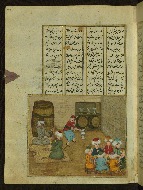
- Title: The poet ʿAṭāʾī talking to a learned man in a tavern
- Form: Illustration
- Text: Nefḥat ül-ezhār
fol. 46b:
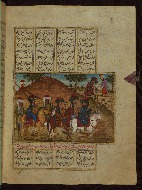
- Title: An assassin sent by the king of Yemen searching for Hatem
- Form: Illustration
- Text: Nefḥat ül-ezhār
fol. 48a:
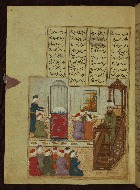
- Title: An imam who put ink, rather than rosewater, on his face
- Form: Illustration
- Text: Nefḥat ül-ezhār
fol. 51b:
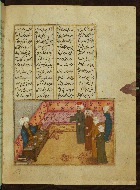
- Title: A juriconsult giving sexual advice
- Form: Illustration
- Text: Nefḥat ül-ezhār
- Label: This illustration depicts a mufti, having heard a complaint from a mother about her son-in-law’s inability to consummate his marriage to her daughter, giving sexual advice.
fol. 55b:
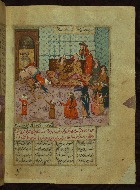
- Title: An adulterous husband and his lover butted by a ram
- Form: Illustration
- Text: Nefḥat ül-ezhār
- Label: This illustration depicts an adulterous husband and his lover being unexpectedly butted by a ram into a room full of surprised guests.
fol. 56a:
fol. 57b:
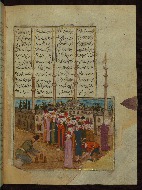
- Title: A pederast
- Form: Illustration
- Text: Nefḥat ül-ezhār
- Label: This illustration depicts a crowd watching a juggler, while punishment is being meted out to a homosexual for his advances on a young boy. The punished figure on the ground is damaged.
fol. 59a:
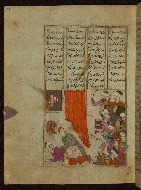
- Title: A sodomite disgraced
- Form: Illustration
- Text: Nefḥat ül-ezhār
- Label: This illustration depicts a sodomite being disgraced before a crowd by drums and a Turkish wind instrument (zurna).
fol. 60a:
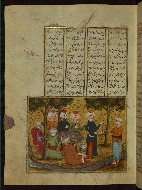
- Title: A thief being bitten by a snake
- Form: Illustration
- Text: Nefḥat ül-ezhār
- Label: This illustration depicts a thief being bitten by a snake while trying to steal the purse of a man dining with friends.
fol. 63b:
fol. 67a:
fol. 69b:
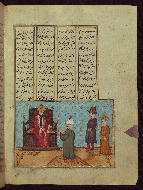
- Title: A messenger from Seljuk Sultan Melikşāh being received by the Byzantine king
- Form: Illustration
- Text: Sobḥet ül-ebkār
fol. 73a:
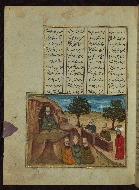
- Title: Plato in a cave with his followers bringing their self-portraits for examination
- Form: Illustration
- Text: Sobḥet ül-ebkār
fol. 77a:
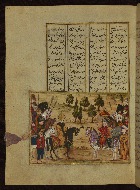
- Title: Meeting of the armies of Alexander the Great and the Emperor of China
- Form: Illustration
- Text: Sobḥet ül-ebkār
fol. 82b:
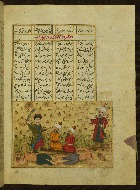
- Title: Two lovers spared from being beheaded due their loyalty for each other
- Form: Illustration
- Text: Sobḥet ül-ebkār
fol. 84a:
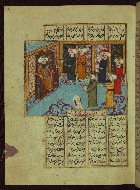
- Title: A shamed man who lied about a three-day journey from Mecca to Nishapur
- Form: Illustration
- Text: Sobḥet ül-ebkār
- Label: This illustration depicts a man embarrassed by his turban falling off to reveal his bald head. When he protests that his virtue is gone, Mansur replies that it was already gone when he previously lied about his miraculous three-day journey from Mecca to Nishapur.
fol. 88b:
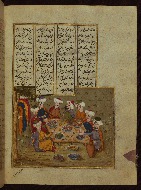
- Title: An innocent youth being entertained by a group of sodomites
- Form: Illustration
- Text: Sobḥet ül-ebkār
fol. 91a:
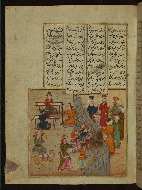
- Title: A man exposing himself through a hole in the fence
- Form: Illustration
- Text: Sobḥet ül-ebkār
- Label: This illustration depicts a man exposing himself through a hole in the fence while the women on the other side tie his penis with a string.
fol. 97b:
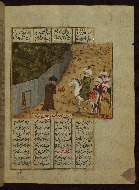
- Title: Caliph Maʾmūn and his soldiers being greeted by a man with a tray of fruit
- Form: Illustration
- Text: Sobḥet ül-ebkār
fol. 107b:
fol. 113b:
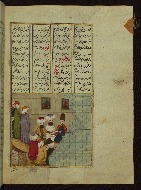
- Title: A learned man
- Form: Illustration
- Text: Heft-ḫvān
- Label: This illustration depicts a learned man, who became ill with desperation after having fallen in love, being entertained by his friends with love stories.
fol. 118b:
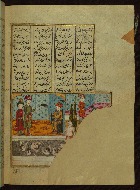
- Title: Hurşid, a Chinese ruler, watching his vizier’s young son swim in a pool
- Form: Illustration
- Text: Heft-ḫvān
- Label: This illustration depicts Hurşid, a Chinese ruler, watching Behzād, his vizier’s young and handsome son, swimming in a pool. The painting has been torn.
fol. 123a:
fol. 124b:
fol. 127a:
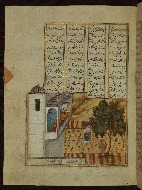
- Title: A king looking at a picture of his son and his tutor, who fell in love with him
- Form: Illustration
- Text: Heft-ḫvān
fol. 130a:
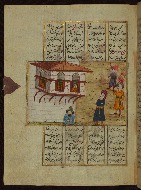
- Title: A young man looking out of the window for his lover Abdullah
- Form: Illustration
- Text: Heft-ḫvān
fol. 134a:
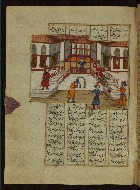
- Title: Mahzun, on his way to visit the emir’s son, being thrown down the stairs by one of the courtiers
- Form: Illustration
- Text: Heft-ḫvān
fol. 137a:
fol. 138a:
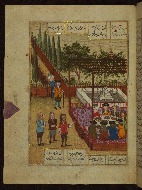
- Title: Tayyib and Tahir at a party with their rescuers in European attire
- Form: Illustration
- Text: Heft-ḫvān
fol. 139b:
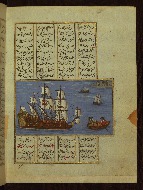
- Title: The ship carrying Tahir and Tayyib being greeted by two Christian nobles in a boat
- Form: Illustration
- Text: Heft-ḫvān
fol. 142b:
The binding is original.
Brown leather binding (with flap); empty center panel with gold-painted frames
Walters Art Museum, 1931, by Henry Walters bequest
For a detailed description of this manuscript, see Renda, Günsel. "An Illuminated 18th-Century Ottoman Hamse in the Walters Art Gallery." Journal of the Walters Art Gallery 31 (1981): 15-32.
For the author, see "ʿAṭāʾī, ʿAṭāʾ Allāh b. Yaḥyā b. Pīr ʿAlī b. Naṣūḥ, known as Newʿī-zāde ʿAṭāʾī." Encyclopaedia of Islam. 2nd ed., s.v.
Principal cataloger: Gacek, Adam
Catalogers: Landau, Amy; Smith, Sita
Editor: Bockrath, Diane
Conservators: Jewell, Stephanie; Quandt, Abigail
Contributors: Barrera, Christina; Emery, Doug; Herbert, Lynley; Noel, William; Simpson, Shreve; Tabritha, Ariel; Toth, Michael B.; Valle, Chiara
The Walters Art Museum
Licensed for use under Creative Commons Attribution-NonCommercial-ShareAlike 3.0 Unported Access Rights, http://creativecommons.org/licenses/by-nc-sa/3.0/legalcode. It is requested that copies of any published articles based on the information in this data set be sent to the curator of manuscripts, The Walters Art Museum, 600 North Charles Street, Baltimore MD 21201.
